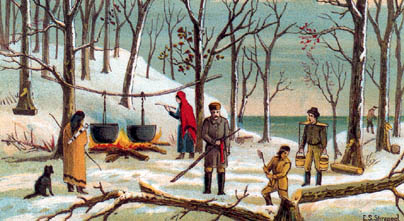MAPLE SYRUP
Thousand-Year-Old Recipe
Products of the sugar and black maple hardwood trees were
well known to First Nations people of the Lawrence and Great Lakes areas before Europeans
arrived. Other maples also produced the basic sap could be boiled into syrup, but, because
the sugar content was much lower, they were used far less. Hence, maple syrup country was
that where hard maples grew numerously: parts of present Maritimes, Southern Quebec and
Ontario, upstate New York, New England, Michigan, and Wisconsin. The making of the
syrup and sugar was and is a North American activity based primarily on the native
deciduous forests spread broadly throughout eastern Canada.
Early European venturers were delighted with the delicious, fragrant sweetness of maple
syrup and sugar - for, until West Indian plantations made cane sugar widely available,
they had mostly known only honey. In 1663 the English chemist, Robert Boyle, described sap
collection as recorded in the accounts of Massachusetts settlers and, in 1673, French
priests in New France similarly sent reports back home.
 |
| Demonstrating a maple sugar bush
and springtime sap gathering, this colourful lithograph, take from Thomas Conant's Upper
Canada Sketches in the late 19th century, illustrates natives with local settlers from the
back country gathering and preparing sap for maple sugar. Today the provice of Quebec
supplies more than 50 percent of the world's supply of maple sugar [C.J. Humber
Collection] |
The people of the First Nations had an age-old collecting
technique. As the warming days of early spring brought sap rising in the maple woods, they
cut a diagonal slash in each lower trunk and inserted a hollow reed through which the sap
dripped into a small bark container. These were subsequently taken to bigger bark or log
containers where fire-heated stones were dropped into them until the sap had boiled down
to a dark, sweet syrup often referred to as "sweet water," especially
when used in the cooking of venison. Further boiling produced maple sugar. European
settlers basically kept to this pattern, merely replacing bark vessels with either wood or
metal pails and large cast-iron kettles hung by chains over boiling fires.
Indeed, for many subsequent generations throughout both French and English Canada, the
"maple moon" month or the "sugaring off" period would remain a special
occasion on the country calendar. Then, in the melting days and freezing nights from March
into April (depending on local weather), rural families would gather at their shanties in
the sugar bush to collect and boil the sap - and to make maple taffy or maple candy for
young and old alike by pouring syrup with the consistency of melted wax out onto a clean,
white snowbank.

|
This 18th century engraving, one
of the earliest known views depicting the making of maple sugar in Canada by aboriginals,
is taken from Moeurs des Sauvages Ameriquains, compare'es aux moeurs des premier temps,
published in Paris in 1724 by P. Lafitau [Royal Ontario Museum] |
Only around the 1940s did methods change. A modernized
maple syrup industry introduced networks of plastic pipes leading from the trees to a
central evaporating plant. Despite this, market demands exceeded supply, and prices
soared.
Today, especially in Southern Quebec and in eastern Ontario, maple syrup and maple sugar
continue to add their flavour (literally) to a distinctive Canadian farm-and-bush
industry.


